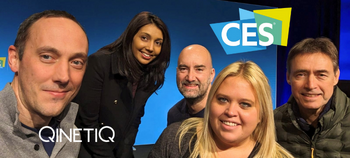CES 2023: Painting innovation
09/03/2023

Traditionally, the defence sector has relied heavily on establishing its own technology development from scratch, but we are now seeing the benefits of transferring established technologies from other industries. It can help us to diversify our capabilities; ensuring we provide our customers with the best solutions to support their most critical missions.
To do this, we must ensure we are driving and nurturing innovation, although this can sometimes be a challenging feat - and not just in defence. A significant majority of ventures across industries will struggle to turn their technologies into innovative products and services within their respective markets. In these cases, there is something to be said about the pitfalls of creating ‘technology for technology’s sake’. A technology is only innovative if it delivers value to the end-user, whether the advances are incremental and small or radical. One exhibit at CES, named ‘The Gallery of Flops’, featured some unexpected technology failures that never quite reached their potential. One showcased ‘flop’ was the Apple Pippin (1990s); a gaming console that saw its own demise mostly due to the shortage of compatible games that could be played on it. The product was not desirable because there was little development of complementary products that would enhance the overall offering to their customers. Another showcased flop was the Rejuvenique face mask that used electrical pulses to stimulate youthful skin. Though desired by its target market, it wasn’t a feasible solution because it didn’t meet product safety requirements. Finally, the well-known DeLorean was marketed as a powerful sports car, but the engine capacity did not deliver on the hype, meaning its misled market placement resulted in a product that was not viable.

Above: ‘The Gallery of Flops’, CES 2023
This exhibit demonstrated the importance of an organisation’s ability to understand their customer and markets. At QinetiQ, we consider the desirability, feasibility and viability of our innovations from inception through to operational delivery to ensure we can address our customers’ mission-critical needs, asking three questions:
- Is this the right thing to do for our customers?
- Can we deliver a solution safely and responsibly?
- Is our solution value for money?
Sometimes this means working collaboratively with partners who can help us to enhance our solutions, recognising that in these cases the whole is greater than the sum of the parts. At CES 2023, it was great to see the number of joint-ventures and cross-industry incubators that were involved in developing some of the most advanced and innovative technologies showcased.
Further to this, collaboration and co-creation demonstrate the criticality of the human contribution to innovation. Technologies like Artificial Intelligence, Metaverse, AR/XR and Quantum - all featuring as running trends at CES - have gained traction in recent years, due to their ability to address our collective human curiosity to push boundaries; whether that is through greater interconnectedness, timesaving automation, or simply entertainment. The make-up of this curiosity however, does highlight one fundamental difference between consumer tech markets and our defence and security customers. For consumer technology, it is enough that we meet people’s desires – for example, how many times have you bought something as an end-user that you don’t need, but you want? However, for military and security organisations, the value-creation is rooted much more fundamentally, as the end-user’s mission will always be grounded in protecting lives. That isn’t to say that military solutions can’t also address the desires of those who operate in challenging environments, but to us, a focus on this need differentiates the Mission-Led Innovation we deliver to our customers from the innovation seen in other markets.
The range of creative technologies on show at CES 2023 allowed us to reflect on what innovation is really all about. It is clear that technology can, and often is, an enabler to innovation, and that innovation is all about generating or enhancing value for the end-user. But it is only through people’s expertise and experience that we can deliver innovative solutions, utilising our innate human ability to understand and work with each other. In other words, if innovation is a painting made up of many brushstrokes (whether those are technologies, services or processes), then it is always a person holding the paintbrush, and it is always a person who will admire the final masterpiece.


Welcome to CES 2023: Tech trends to watch out for
Our innovation team are back in Las Vegas for CES 2023. This blog explores some of the key global challenges and how technology trends can help to mitigate these. It also addresses how defence, security and critical infrastructure sectors might learn from, exploring their potential value to industry customers.


